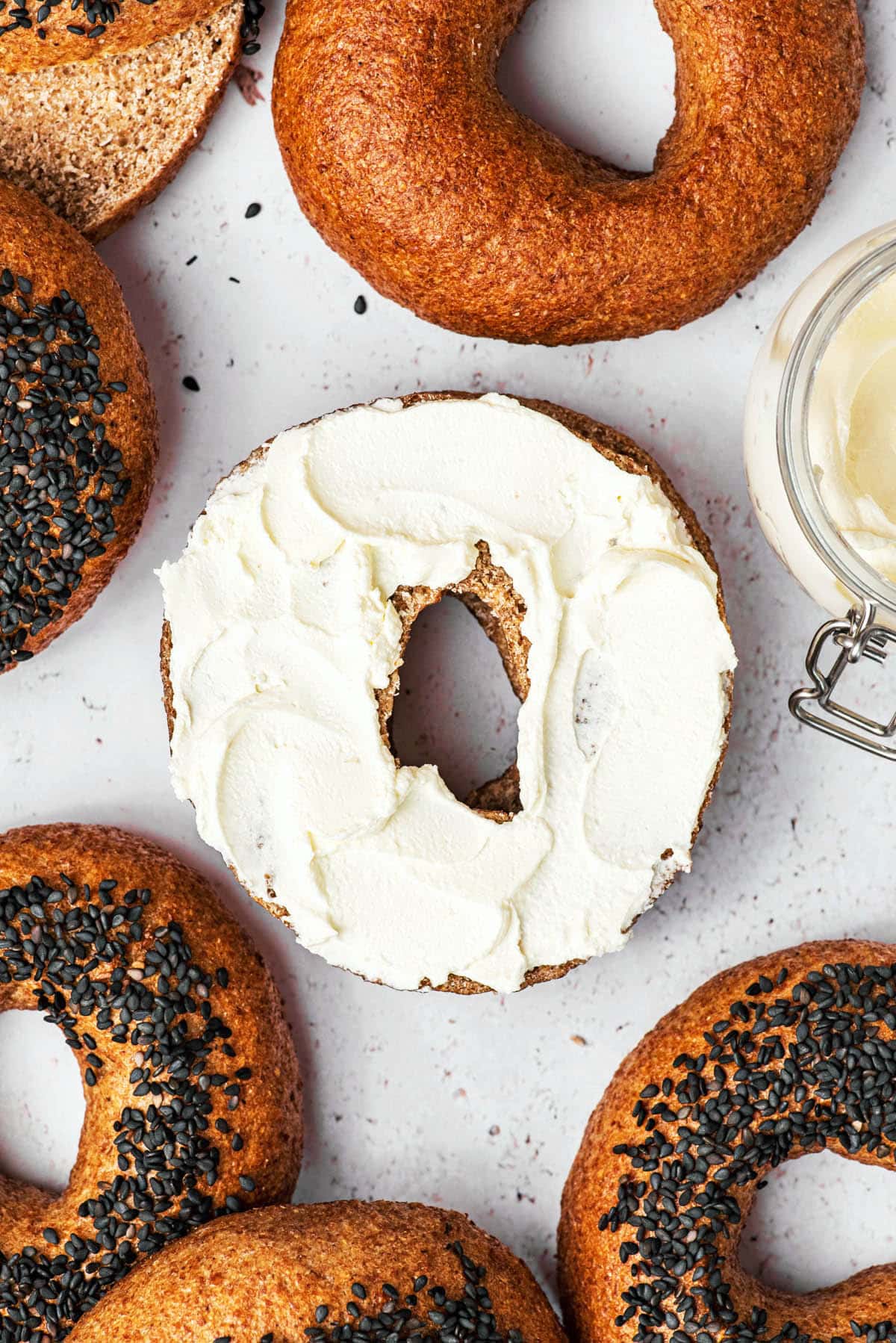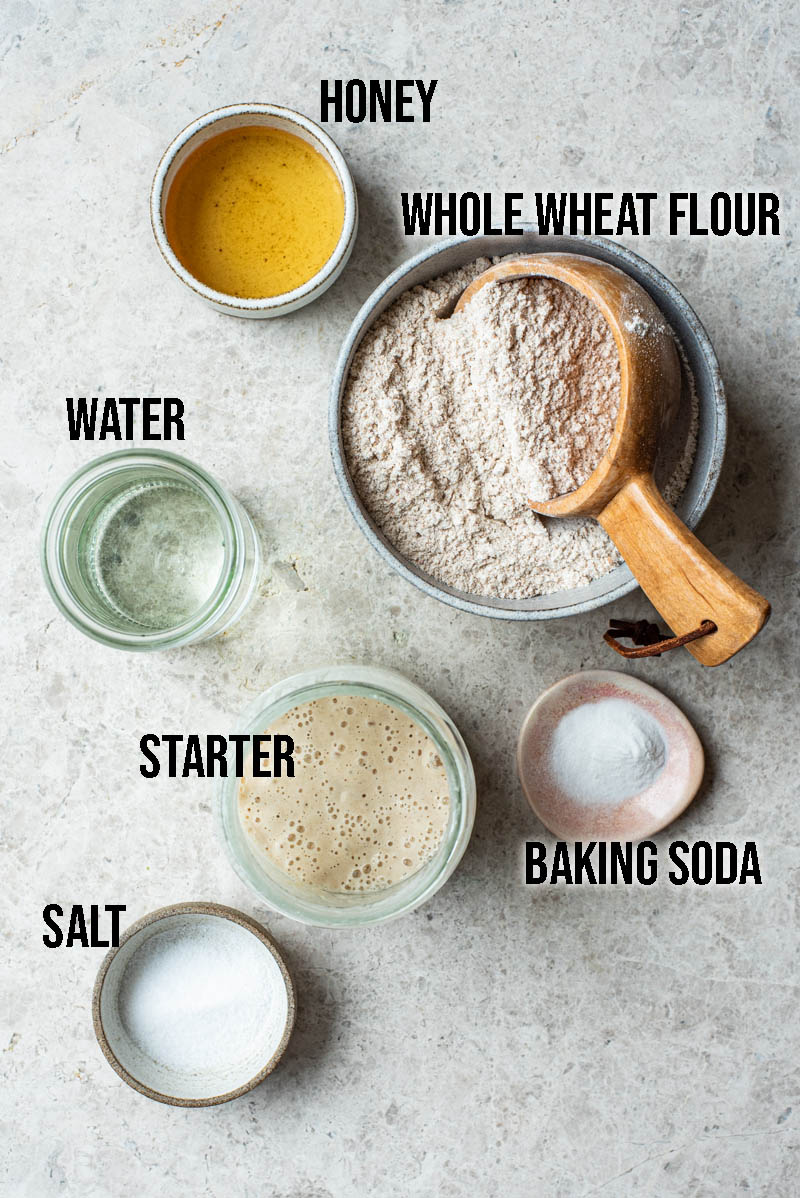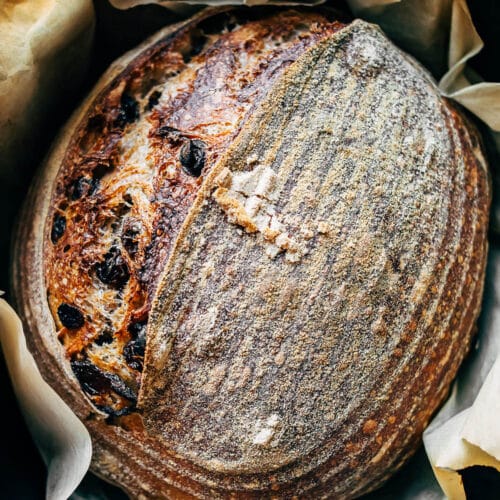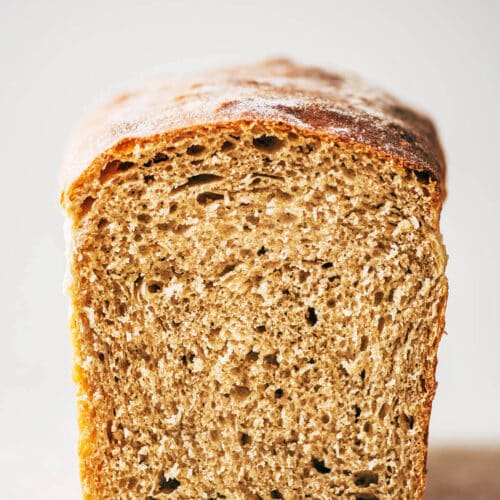There's no better breakfast than a good bagel with cream cheese, and these 100% whole wheat sourdough bagels are a healthier version of the classic. Even with plain flour, sourdough always has a superior flavour. With nutty whole wheat flour, though, you get the best of both worlds.
You need some time, as with all sourdough recipes, but the active work needed isn't very much. That being said, they do need kneading, and we recommend doing it by hand - it's a low hydration dough. Love to use whole grains in sourdough? Try our whole wheat sourdough bread and sprouted grain sourdough, too.

Jump to:
Ingredients

Ingredient Notes and Substitutions
- Whole wheat flour: if you don't want to go all whole wheat, you can do half white and half whole wheat. Whole wheat bread flour can also be used.
- Sweetener: honey, molasses, and maple syrup can all be used interchangeably in this recipe, with slight changes in flavour. Use whichever you like the most. These are much easier to find than malt syrup, but it can be used if preferred.
- Starter: any type of active sourdough starter will work here. White flour, whole wheat, rye, etc. are all fine, as long as it's strong.
- Toppings: use whatever toppings you like. Sesame seeds, herbs and spices (everything bagel spice), za'atar, anything you like.
Method

Step 1: mix the starter and water, then stir in the dry ingredients to form a shaggy dough.
Step 2: knead the dough by hand until soft and smooth.
Step 3: form ten equal balls of dough, rotating to get some surface tension.
Step 4: form holes in the balls with your fingers. Aim for the holes to be about half the width of the bagel.

Step 5: set the bagels on a lined baking sheet to prove.
Step 6: they should almost double in size after a few hours.
Step 7: boil the bagels in simmering water, and they should increase in size again.
Step 8: bake until golden brown and cool before slicing.
Top Tips
- Make them less chewy: if you want softer bagels, boil them for about half the time. A slightly shorter boiling time is fine, but too long (for even chewier bagels) and you risk causing the bagels to rise less in the oven.
- Keep the water steady: make sure the water is at a constant simmer when boiling the bagels, and turn it up after adding them if needed to keep it consistent.
- Knead by hand: unless you have a professional grade standing mixer, you're better off kneading these by hand. A cheaper mixer might (probably will) burn out the motor.
Recipe Notes
Boiling is mandatory for bagels, and it's what creates that thin chewy outer layer. The boiling time is given as a range, so keep an eye on your bagels - you'll notice that they expand significantly in the hot water. Once they've stopped changing, you can take them out.
Baking soda is added to the water to make it more alkaline. It's a substitute for the more dangerous lye, and adds a nice dark, chewy exterior crust to the bagels. Just a small amount makes a big difference.
Honey, molasses, or maple syrup is added to the water for a touch of sweetness, and also to increase the chewiness of the bagels.
This is a slightly higher hydration dough than many white-flour sourdough bagels, because whole wheat flour absorbs more water (this is why hydration percentages can be so tricky for beginners!). It's deceptively soft if you're using to making other bagels, but don't be fooled - the whole grains will absorb that liquid as it rests.
The Float Test
The proving time will vary, and this is why the float test is so important. If your bagels float after two hours in a warm house, great, time to refrigerate.
If your starter is a bit sluggish, or your house is chilly, the bagels might need a lot longer to prove. In the winter, it might be all day before they're ready.
That being said, if your bagels don't pass the float test, and you're tired of waiting, you can try to refrigerate overnight as usual. They may rise a bit more in the fridge, and usually they turn out fine, if not perfect, if they didn't quite float.
You can see in the process images above how much the bagels rise in the first proving period at room temperature. They don't quite double, but it's close. This is sourdough - be patient!
Refrigerate Before Cooking
The shaped bagels, once proved, are a little difficult to handle, and tend to lose their shape. Refrigeration makes them easier to move into the boiling water without stretching the dough, and improves the overall sourdough bagel taste.
It is possible to skip the long ferment in the refrigerator, after the bagels have proved at room temperature. This chilling period is to improve flavour, not necessarily for the bagels to rise any further. If you don't care for that sourdough flavour, skip the refrigeration and go right to boiling.
FAQ
What do you eat with sourdough bagels?
You can eat all the same things with sourdough bagels as you would with any other bagels – classic cream cheese, smoked salmon, avocado, peanut butter, make pizza bagels, and more. The possibilities are endless.
Why are my sourdough bagels sinking?
If your sourdough bagels are sinking in the water and not rising right away, they're either under- or over-proved. This will cause them to sink during the boiling step and collapse when they're out of the water.
Why are my sourdough bagels tough?
If your bagels are tough, it may be either due to under-proving or that too much flour was added during the kneading process. This is especially true for whole wheat bagels, while don't need flour added, as the whole grains absorb more water.
If you make this Whole Grain Sourdough Bagel recipe or any other sourdough recipes on the Baked Collective, please take a moment to rate the recipe and leave a comment below. It’s such a help to others who want to try the recipe. For more baking, follow along on Instagram, TikTok, and YouTube.
100% Whole Wheat Sourdough Bagels
Equipment
- Mixing bowl
- Whisk
- Bread machine optional
- Tea towel
- Beeswax wrap optional
- Measuring cups and spoons or a digital kitchen scale
- baking sheet
- Parchment paper
- Large pot
- Wire rack
Ingredients
- 315 grams water
- 200 grams active starter
- 30 grams honey or maple syrup
- 650 grams whole wheat flour
- 10 grams sea salt
- Flour for proving
- Toppings as desired
For Boiling
- 1 tablespoon baking soda
- 1 tablespoon honey or brown sugar
Instructions
Day One
- Add the water, starter, and honey or maple syrup to a large bowl (or the bowl of your standing mixer) and whisk until well combined.
- Add in the flour and salt, and stir until a shaggy dough forms. Turn the dough out onto a work surface and knead until smooth and pliable, about 10 minutes. Alternatively, transition to a dough hook and knead by machine.
- Shape the dough into a ball and return to the bowl. Cover the bowl with a towel and set aside to rest for 20 minutes.
- Once the dough has rested, take it out of the bowl and weigh it. The total weight should be about 1100 grams.
- Divide the dough into 10 equal pieces, weighing each piece to ensure accuracy.
- Shape each piece into a small ball by tucking the corners underneath, cupping the dough, and rolling it in a circular fashion on a clean, flour-free work surface. This helps to create surface tension and a skin on the ball.
- Cover dough balls and rest another 15 minutes. Line a baking sheet with parchment paper and sprinkle generously with flour or semolina. Note, if your baking sheets are small, you may need two.
- To shape the bagels: poke a hole with your finger directly through the centre of the dough ball. Insert both index fingers into the hole and roll fingers around each other to stretch out the centre (like a barrel roll) until it’s about the size of a walnut. Place on the lined baking sheet and repeat with the rest of the bagels.
- Cover the shaped bagels with a damp tea towel and let them prove at room temperature for 2.5-4.5 hours, or until puffy and about doubled in size. This could take more time, depending on the temperature in your house.
- Take a test bagel and place it in a dish full of cold water. If it floats, they’re done proving. Dry the test bagel off and return to the baking sheet. If it sinks, it still needs to prove longer.
- Once proved, cover the pan(s) with a damp tea towel, or beeswax wrap and refrigerate for 12-24 hours, or overnight.
Day Two
- Preheat the oven to 400°F (200°C). Place any toppings on flat plates, so they're ready to go.
- Bring a large pot of water to a rolling boil and add the baking soda and honey or brown sugar.
- Remove the bagels from the fridge and gently place them, 2-3 at a time, into the water. Boil for 20-30 seconds on each side.
- Remove boiled bagels with a slotted spoon to get rid of most of the water.
- Shake off excess water and immediately dip the top of the bagel into desired toppings. Set it back on the baking sheet. Repeat this process with the remaining bagels.
- Place the baking sheet into the centre of the oven.
- Bake for 18-22 minutes or until golden on top. Cool fully on a wire rack before slicing and serving or storing. Excess bagels freeze well - we recommend slicing them before freezing for easy toasting.





Hi, is the baking soda in the boiling water due to these being 100% whole wheat? Or could we omit that and use barley malt syrup?
Hi there, the baking soda is to replicate lye in traditional bagels, and it makes them chewier. You can omit but the texture will be different.
Hi! I make your sourdough ny style bagels and my family loves them!! However, the recipe isn’t showing up anymore! I know the general gist I just need the measurements in grams if you could post. My whole family would be very grateful. Thank you so much!
Hi Elizabeth, those bagels are over on the old site, which looks like it's down now. You can use this recipe but add an extra 50g flour (and use all strong bread flour). We are planning on sharing another NY style bagel recipe here in the near future but in the meantime this is one very similar 🙂
I totally came here to ask the same thing. I want to say the old recipe was for 750 grams of AP flour, 10 grams of fine sea salt, 30 grams of barley malt syrup, 315 grams of water, 200 grams of fed starter. 1 TBSP of baking soda and tablespoon of brown sugar in the water. I started doubling both of those.
We will be adding a white-flour sourdough bagel recipe to this site soon - the old Baked website is no longer functional due to a lack of updates, but we will be sharing a standard sourdough bagel and basic sourdough bread in the next month or two.
These came out incredibly!! The dough was much easier to handle after proofing than other sourdough bagel recipes I’ve tried using bread flour (too sticky!). These bagels were perfectly round, puffed, and golden brown. They taste so good of sourdough!!! Thank you so much!!!
We're so happy you like the recipe, thanks Angeli!